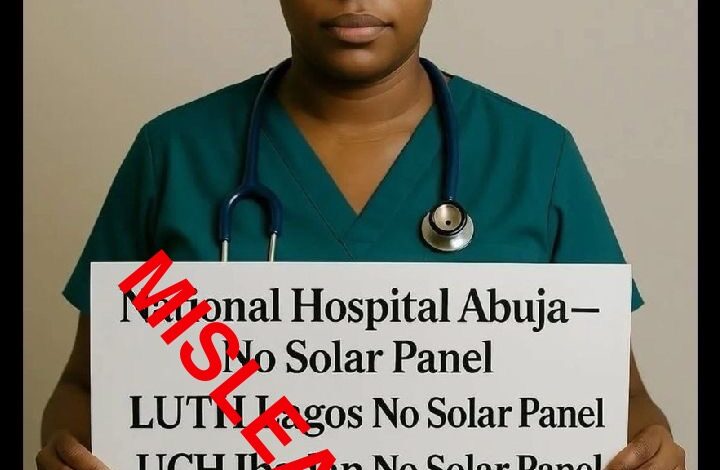
BY: Oluwaseye Ogunsanya
Claim
Veteran Journalist Jimi Disu reposted a set of claims alleging that National Hospital Abuja, Lagos University Teaching Hospital (LUTH), University College Hospital Ibadan and Ahmadu Bello University Teaching Hospital have no solar panel.
Verdict
Misleading. Credible reports show that some of the mentioned teaching hospitals use solar power at various capacity levels but there is no evidence for National Hospital, Abuja.
Full Text
Veteran Journalist Jimi Disu reposted a set of claims alleging that National Hospital Abuja, Lagos University Teaching Hospital (LUTH), University College Hospital Ibadan and Ahmadu Bello University Teaching Hospital have no solar panel.


Screenshot of the claim
The post which was lifted from the Facebook page of one Ikeddy Chinedu Isiguzo here berated the Federal Government for allocating the sum of N10bn in the 2025 approved budget for the installation of a solar mini-grid for the State House, Aso Villa, Abuja. This development sparked criticism from many social media users, who described it as a reflection of the government’s lack of seriousness in addressing Nigeria’s chronic power supply issues and the persistent instability of the national grid.
However, defending the Federal Government’s decision, the Director-General of the Energy Commission of Nigeria, Mustapha Abdullahi, stated that it is financially unsustainable for the Aso Rock Presidential Villa to continue spending approximately ₦47 billion annually on electricity bills. Speaking during a press briefing last Friday, Abdullahi explained that the transition aligns with the President’s broader agenda to diversify the country’s energy mix and reduce the cost of governance. The claims can also be found here, here, here, and here.
Context
Over the years, public tertiary hospitals in Nigeria have grappled with persistent blackouts, largely due to overwhelming electricity debts that continue to strain their already limited budgets. A striking example is the University College Hospital (UCH), Ibadan, which recently endured a power outage lasting over 100 days following disconnection from the national grid by the Ibadan Electricity Distribution Company (IBEDC). The disconnection was reportedly due to an outstanding debt of approximately ₦400 million, accumulated since 2019.
This crisis has been exacerbated by the migration of most public tertiary hospitals and educational institutions to Band A, after the National Elecricity Regulatory Commission (NERC) increased electricity tariffs. Under the new structure, Band A customers—those expected to receive at least 20 hours of power supply daily—saw their tariff rise from ₦68/KWh to ₦225/KWh, representing a 300% increase. Other bands have also seen varying degrees of hikes. As a result, many of these institutions have raised alarms over skyrocketing electricity costs.
According to PUNCH Healthwise, despite the approval of a 50 per cent subsidy for electricity consumed in public hospitals in August 2024, several major teaching hospitals are still receiving staggering monthly bills, including: UCH, Ibadan – ₦99 million, Lagos University Teaching Hospital (LUTH) – ₦140 million, Ahmadu Bello University Teaching Hospital – ₦80 million, Obafemi Awolowo University Teaching Hospital Complex – ₦40 million, Aminu Kano Teaching Hospital – over ₦100 million, Abubakar Tafawa Balewa University Teaching Hospital, Bauchi – ₦50 million, Jos University Teaching Hospital – ₦30 million, University of Nigeria Teaching Hospital – ₦50 million
These mounting costs have intensified calls for more sustainable and affordable power solutions in the nation’s health sector, hence the need to verify these claims.

Screenshot of Ikeddy’s post on Facebook
Verification
FactCheckAfrica conducted a verification process to assess claims regarding the Federal Government’s solar energy installations in federal teaching hospitals. Through open-source checks and media reports, we found credible evidence confirming the government’s plans and actions in this regard.
Firstly, Nigerian Tribune reported that the Federal Government earmarked ₦100 billion in the 2025 national budget (awaiting national assembly approval) for the installation of solar mini-grids across select federal universities and teaching hospitals, including the University of Ibadan (UI) and University College Hospital (UCH), Ibadan, University of Lagos (UNILAG), Obafemi Awolowo University (OAU), University of Nigeria (NSUKKA), and Ahmadu Bello University (ABU). This initiative, according to the Managing Director of the Rural Electrification Agency (REA), Abba Aliyu, is part of the National Public Sector Solarisation Initiative, spearheaded by the Federal Ministry of Power to reduce the cost of governance and enhance sustainable electricity supply. The newspaper also reported that Aliyu confirmed that solar mini-grids will be deployed to UCH and four other universities to resolve the challenge of power outage in Federal Government owned teaching hospitals and universities.
Specifically, in line with this national effort, the Lagos University Teaching Hospital (LUTH), Idi-Araba, began adopting solar energy in 2024 to ensure a stable electricity supply amidst rising tariffs and mounting unpaid electricity bills by government agencies. According to The Nation, LUTH had been facing severe financial strain, reportedly spending ₦150 million monthly on electricity, while receiving only ₦14 million in government subsidies. Escalating gas prices also impaired its gas-powered hybrid system. In response, the hospital piloted a solar alternative at Ward A, achieving 91.7% electricity generation from solar and only 8.3% reliance on the public grid. Additionally, the Moses Adekoyejo Majekodunmi Foundation (MAMF) donated and installed a 12.5kVA / 20kW solar power system at Ward A2, further strengthening LUTH’s energy resilience.
Similarly, BusinessDay reported in January 2023 that SAO Energy, in collaboration with the Akeredolu Foundation, deployed a hybrid solar system—the largest of its kind in a Nigerian teaching hospital—targeted at powering essential units such as the hemodialysis centre, staff quarters, and surrounding communities. The system consists of a 36,000Wp solar PV array with battery storage, generating up to 80kWh and ensuring consistent electricity for critical medical equipment and services.
Also, in response to viral claims that families of patients had to bring personal generators and inverters to power medical equipment at UCH, the hospital’s Public Relations Officer, Funmi Adetuyibi, debunked the allegations. She emphasized that UCH has adopted a phased approach to improve energy access, prioritizing critical departments such as the Accident and Emergency Unit, Labour Ward, Theatres, and Wards through the deployment of solar inverters and diesel-powered generators.
“Indeed, we have since embarked on a phased approach, including the provision of alternative energy (solar inverters and diesel-powered generators) in critical units such as the wards, accident and emergency, labour ward and theatres.” She said
In a related development, the Chief Medical Director (CMD) of Ahmadu Bello University Teaching Hospital (ABUTH), Shika, Kaduna State, Prof. Ahmed Hamidu, announced in May 2024 the hospital’s plan to transition to renewable energy. He expressed concern over the facility’s monthly electricity bill of ₦75 million, describing it as financially unsustainable. According to Prof. Hamidu, each critical department and unit block within the hospital would gradually migrate to renewable energy solutions over time.
Meanwhile, there are currently no publicly available reports confirming that the National Hospital, Abuja is powered by solar energy.
Overall, these findings highlight the growing efforts by both the Federal Government and independent foundations to improve electricity supply in Nigerian teaching hospitals, with a strong emphasis on solar energy as a sustainable alternative.
Conclusion
The claim is misleading. Credible reports show that some of the mentioned teaching hospitals use solar power at various capacity levels but there is no evidence for National Hospital, Abuja.




